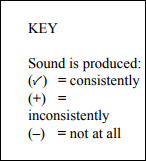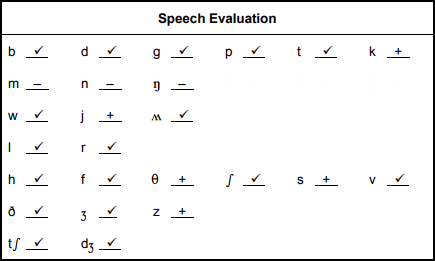Study Guide
Field 062: Deaf and Hard of Hearing
Sample Multiple-Choice Questions
Expand All Answers | Collapse All Answers
Subarea 1—HUMAN DEVELOPMENT AND STUDENTS WITH SPECIAL EDUCATIONAL NEEDS
Objective 001
Understand normal human development from infancy to 11 years.
1. Which of the following activities reflects the highest degree of language development likely to be demonstrated by most five-year-old children?
- understanding children's stories
- asking simple questions
- singing songs from memory
- following two-step commands
- Enter to expand or collapse answer.Answer expanded
- Correct Response: C.
Objective 008
Understand speech and language impairments.
2. Which of the following speech behaviors would be considered an articulation disorder?
- stuttering
- sound substitution
- excessive nasality
- inappropriate vocal volume
- Enter to expand or collapse answer.Answer expanded
- Correct Response: B.
Subarea 2—HEARING IMPAIRMENTS
Objective 011
Identify characteristics and levels of hearing impairment.
3. A student with a sensorineural hearing loss is most likely to experience which of the following?
- reduced ability to hear what is said in noisy settings
- periodic ringing in the ears
- extreme sensitivity to high-pitched sounds
- episodes of temporary hearing loss
- Enter to expand or collapse answer.Answer expanded
- Correct Response: A.
Objective 017
Understand the hearing mechanism.
4. Which organ of the ear is primarily responsible for converting the mechanical action of the middle ear into an electrical signal in the inner ear that is then transmitted to the brain?
- tympanic membrane
- vestibule
- Eustachian tube
- cochlea
- Enter to expand or collapse answer.Answer expanded
- Correct Response: D.
Subarea 3—ASSESSMENT
Objective 025
Understand methods used to assess auditory functioning.
5. In assessing auditory functioning, a bone-conduction test is primarily used to:
- measure overall level of hearing sensitivity.
- determine the threshold of speech awareness.
- measure the level of hearing in the middle ear.
- determine if loss is conductive or sensorineural.
- Enter to expand or collapse answer.Answer expanded
- Correct Response: D.
Objective 027
Understand methods used to assess the speech and language development of children with hearing impairments.
6. Use the student speech assessment data below to answer the question that follows.


The key indicates that a checkmark means the student produces the sound consistently, a plus sign means the student produces the sound inconsistently, and a minus sign means the student produces the sound not at all.
The data consists of a list of sounds with either a checkmark, a plus sign, or a minus sign next to each. I will now read the list.
B, checkmark.
D, checkmark.
G, checkmark.
P, checkmark.
T, checkmark.
K, plus sign.
M, minus sign.
N, minus sign.
Eng, minus sign.
W, checkmark.
J, plus sign.
Upside-down W, checkmark.
L, checkmark.
R, checkmark.
H, checkmark.
F, checkmark.
Theta, plus sign.
Esh, checkmark.
S, plus sign.
V, checkmark.
Eth, checkmark.
Ezh, checkmark.
Z, plus sign.
T esh, checkmark.
D ezh, checkmark.
According to these assessment data, the student is experiencing most difficulty with which type of consonants?
- liquids
- nasals
- plosives
- semivowels
- Enter to expand or collapse answer.Answer expanded
- Correct Response: B.
Subarea 4—PROGRAM DEVELOPMENT AND INTERVENTION
Objective 030
Understand the development of Individualized Education Programs (IEPs) for students with hearing impairments.
7. The IEP of a student with a hearing impairment and special education needs must include:
- evidence from research findings documenting the appropriateness of approaches selected for use.
- lesson plans to meet stated IEP objectives.
- a summary of projected annual costs and staff hours required for implementing the IEP.
- annual goals for the student's program.
- Enter to expand or collapse answer.Answer expanded
- Correct Response: D.
Objective 037
Apply techniques for stimulating the language development of students with hearing impairments.
8. Family members could best increase the vocabulary and oral language skills of an elementary student with a hearing impairment by:
- placing labels on items in the home used by the child and encouraging the child to repeat the word on a label when using each item.
- reviewing each day's language lessons with the child after he or she returns home from school.
- exposing the child to new activities and experiences and discussing them with the child.
- having the child practice songs sung by family members and repeat phrases and sentences spoken by family members.
- Enter to expand or collapse answer.Answer expanded
- Correct Response: C.
Objective 038
Understand techniques for developing and improving the speech production of students with hearing impairments.
9. A student with a hearing impairment emits excessive breath when pronouncing the letter h. Which of the following is a visual medium that would be especially helpful in addressing this problem?
- a paper strip placed in front of the face
- a mirror
- a light activated by a microphone
- a Visi-Pitch machine
- Enter to expand or collapse answer.Answer expanded
- Correct Response: A.
Subarea 5—PROFESSIONAL KNOWLEDGE
Objective 050
Understand methods of communicating with and counseling students with hearing impairments and their families.
10. A special education teacher wishes to help the parents and guardians of students with hearing impairments gain a better understanding of how to address the special needs of their children. This objective could be met most effectively by organizing a parent workshop that focuses on which of the following topics?
- the etiology of types of hearing impairments
- instructional techniques for students with hearing impairments that can be applied in a variety of settings
- the interpretation of student hearing assessment results
- procedural requirements related to the development of IEPs for students who have hearing impairments
- Enter to expand or collapse answer.Answer expanded
- Correct Response: B.